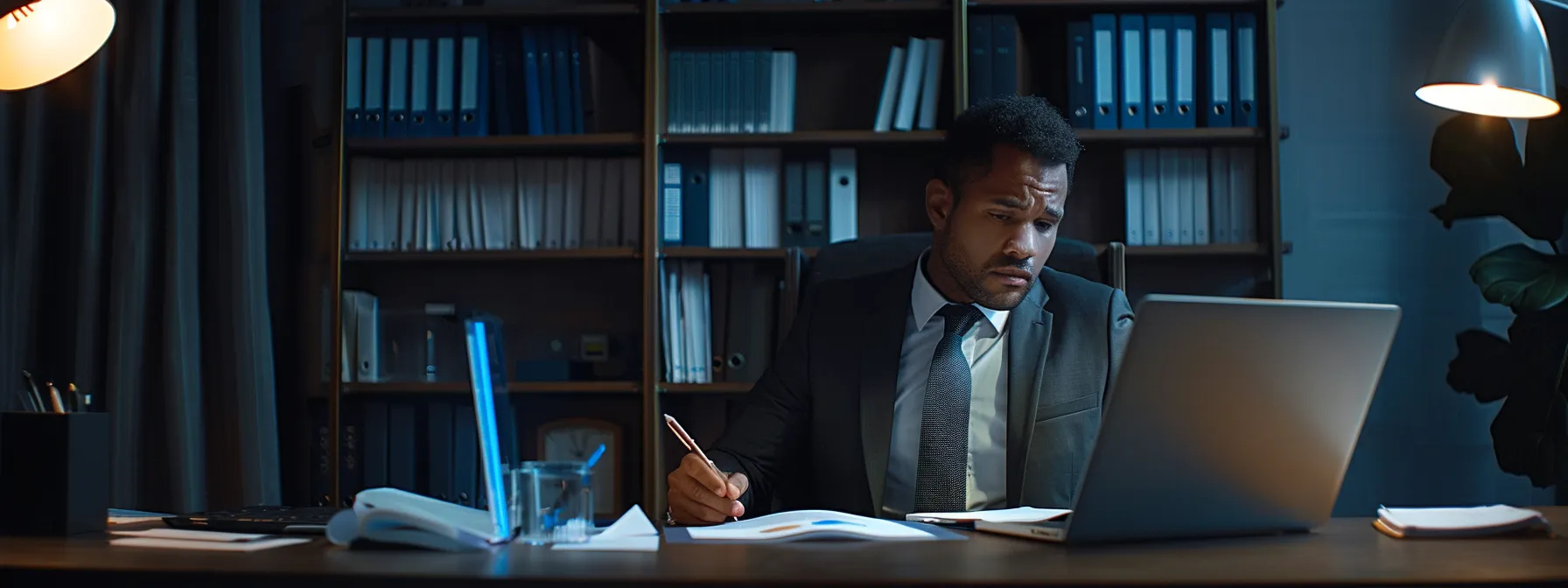If you’ve ever experienced a slip and fall or sustained a catastrophic injury on the highway, understanding how comparative negligence could affect your claim is crucial. This article gives succinct, practical guidance on navigating the legal maze following an accident. It underscores the importance of collecting robust evidence, the nuances of dealing with insurance policy aspects, and choosing a proficient attorney who aligns with your needs. For the reader facing the daunting task of claiming what is rightfully theirs, this content demystifies the process and sets the stage for maximizing compensation. By diving into this well-crafted advice, you stand to turn your personal plight into a powerful case for remuneration.
Key Takeaways
- Proper legal guidance post-accident ensures victims safeguard their rights and maximize claims
- Knowing the statute of limitations is crucial for timely and successful personal injury claims
- Evidence, especially photographs and medical records, is essential for substantiating insurance claims
- Choosing an attorney with specific accident claim expertise influences the compensation outcome
- Prompt medical care and reporting to authorities are fundamental steps in strengthening a legal case
Understanding Your Legal Rights After an Accident

Car accident victims often face a complex web of concerns, from assessing health needs to navigating an array of legalities. Chief among these is understanding one’s rights post-accident, including the identification of the type of incident and the laws that govern it. Prompt attention to the statute of limitations for claims ensures that victims take timely action towards recovery. Veteran expertise from Heil Law Firm about the actual cash value of damages can significantly influence the trajectory of a claim. This section provides a foundational guide for individuals to grasp the essentials of their legal standing following an accident. Contact Heil Law for expert Personal Injury Services.
Identify the Type of Accident and Applicable Laws
In the aftermath of an auto accident, a clear understanding of the specific incident type and the laws that apply is paramount. If neck injuries are sustained, the legal grounds may differ compared to other bodily harm due to varying degrees of contributory negligence that each state acknowledges. This knowledge forms an essential checklist for victims, aid in accurately framing their case, and setting realistic expectations regarding financial compensation.
Each auto accident carries its unique facts and subsequent legal considerations, which impact the outcome of a claim. Proper identification and articulation of the accident details, guided by an experienced legal professional, ensure that the victims’ rights are safeguarded while navigating through the complexities of insurance and finance regulations. This initial step is crucial for building a strong foundation for a successful claim and for obtaining a fair resolution.
Recognize the Statute of Limitations for Claims
Recognizing the statute of limitations is pivotal for victims seeking a car accident settlement. The law firm representing victims must act within this window, a period which dictates the timeframe within which legal action can be initiated. This complexity often confounds individuals, who may unknowingly forfeit their right to compensation due to expired timelines. Legal professionals bring clarity to these time-sensitive stipulations, ensuring that client behavior falls within the bounds of legal requirements for claim submission.
Within the nuanced marketing of personal injury law, awareness of the statute of limitations emerges as crucial for securing a just outcome. Delayed acknowledgment or action could mean the difference between a satisfactory settlement and a dismissed claim. The expert team at the law firm can demystify the statutory timeframe and navigate the intricacies of the legal system, all to shield the clients from the harsh consequences of missed deadlines. Prompt and informed action is the linchpin of a successful car accident claim.
Gathering Essential Evidence to Support Your Claim

To maximize a personal injury claim, collecting robust evidence is critical. Photographs taken at the scene can serve as indisputable proof of the circumstances, potentially strengthening one’s position. Obtaining police reports provides an official account of the incident, which is invaluable during legal proceedings. Additionally, relevant medical records substantiate the extent of injuries sustained, linking them directly to the accident. This evidence becomes pivotal when negotiating compensation for income loss, understanding the ramifications of a total loss vehicle, or even in complex cases such as a dog bite facilitated by negligent text messaging. It’s imperative that this evidence gathering is approached with meticulous care to cement the foundation of a strong claim.
Collect Photographic Evidence at the Scene
After a car accident, securing photographic evidence is a crucial step on the car accident checklist. Capturing clear images of the vehicles, surrounding environment, and any injuries helps illustrate the event’s impact on one’s quality of life. These visuals offer tangible proof to question any discrepancies in reports from insurance companies and can expedite the claims process.
The act of documenting injuries through photos immediately following an accident provides a reliable basis for any claim. It prevents insurance companies from downplaying the severity of injuries and helps legal professionals advocate for appropriate compensation. A picture, in this context, is more than a visual aid; it is a pivotal piece of evidence supporting the victim’s narrative:
| Element of Scene | Description | Use in Claim |
|---|---|---|
| Vehicles’ Position | Illustrates point of impact and possible negligence | Establishes fault and liability |
| Injury Evidence | Documents physical harm done | Correlates injuries with the accident |
| Road Conditions | Provides context for the crash | Influences the determination of fault |
| Traffic Signage | Identifies potential contributing factors | Supports the victim’s account of events |
Obtain Police Reports and Medical Records
Securing a police report immediately after a Chicago car accident serves as an official documentation of the facts, which is indispensable when seeking redress through the legal system. With accurate details such as brake functionality, vehicular damage, and driver accounts, lawyers can construct a precise narrative that strengthens their client’s case. Moreover, having police involvement establishes a degree of veracity and urgency that can influence the negotiations with auto insurance companies.
Similarly, obtaining comprehensive medical records is non-negotiable for substantiating the physical and emotional toll of an accident. This vital documentation paints a clear picture of the immediate and ongoing medical care required, reinforcing the gravity of the situation to family law courts or insurance adjudicators. Lawyers can then leverage these records to advocate for adequate compensation that encompasses not only current treatment costs but also anticipates potential long-term care needs.
| Document Type | Purpose in Claim | Benefit to Client |
|---|---|---|
| Police Report | Establish facts and liability | Supports legal strategy and aids in swift claim processing |
| Medical Records | Verify injury and treatment | Quantifies damages for accurate compensation |
Selecting the Best Accident Attorney for Your Needs

Navigating a personal injury claim can be a headache, but selecting the right attorney specialized in accident claims can smooth the path toward just compensation. In the United States, where traffic tickets and commercial vehicle accidents abound, the choice of an attorney is critical. Prospective clients must research legal expertise in accident cases, thoroughly evaluate an attorney’s experience and success rates, and ensure their choice aligns with the specifics of their claim. Doing so can significantly impact the outcome of one’s case, providing the client with the support needed to successfully navigate the complexities of personal injury law.
Research Attorneys Specializing in Accident Claims
Identifying attorneys with a strong background in car accident claims is a critical first step for any victim seeking compensation. Their comprehensive understanding of the damages framework and the nuances in valuation of market value for total loss vehicles ensures robust management of your claim. An attorney adept in interpreting complex scenarios, such as accidents involving a disregarded stop sign, can make all the difference in articulating a compelling case:
| Attorney Criteria | Benefit to Claim |
|---|---|
| Specialization in Car Accident Claims | Targets expertise to case specifics for optimal results |
| Experience with Total Loss Valuation | Ensures fair market value compensation for severe vehicle damage |
| Understanding of Damages and Compensation Structures | Maximizes claim potential across a full spectrum of damages |
| Strategic Case Management | Streamlines the process, focusing on efficient and effective claim resolution |
The selection process should include reading testimonials and examining past success stories, looking for evidence of the attorney’s proficiency in increasing settlement amounts. Their track record in managing the intricacies of car accident claims, along with securing compensation that reflects the true market value of damages incurred, directly speaks to their capacity to handle your case successfully and diligently.
Evaluate Experience and Success Rates
Evaluating the experience and success rates of potential attorneys ensures that individuals select a legal advisor adept at navigating the complexities of personal injury claims. An attorney’s history of successfully quantifying ‘pain and suffering’ and securing fair compensation for ‘passengers’ contributes to a robust practice, one that is seen favorably by courts and insurance companies alike. Through examining an attorney’s track record, clients gain insight into their ability to strategically negotiate settlements that duly reflect the gravity of sustained injuries.
Success in personal injury cases often hinges on an attorney’s proficiency in collaborating with ‘physicians’ to substantiate claims or using evidence such as ‘camera’ footage effectively. Some cases may involve unique aspects like ‘dram shop’ laws, requiring an attorney with specific expertise in such matters. Prospective clients should look not only at an attorney’s overall win rate but also at the relevance of their experience to the particulars of the client’s situation:
| Attorney’s Experience Factor | Relevance to Personal Injury Case |
|---|---|
| Collaborations with Physicians | Ensures medical evidence is accurately presented and undeniably linked to the claim. |
| Use of Video Evidence | Augments fact-based negotiations, often yielding higher compensation for clients. |
| Expertise in Specific Laws | Can deftly handle cases with specialized circumstances, such as ‘dram shop’ liability. |
It is the combination of seasoned experience and a proven success rate that positions an attorney as an invaluable asset to one’s claim. Through meticulous analysis of these facets, individuals can align with a legal professional who will diligently protect their interests and champion the pursuit of just compensation.
Negotiating With Insurance Companies Successfully

Negotiating with insurance companies is a crucial stage in maximizing a personal injury claim, especially when incidents of negligence lead to serious repercussions like amputation. Crafting a detailed demand letter outlines the victim’s expectations, derived from the losses incurred, and highlights the need for appropriate compensation under personal injury protection coverage. Responding to settlement offers requires strategic consideration to ensure just compensation for the injured party. These steps, essential to the negotiation process, demonstrate the victim’s resolve and understanding of their rights after obtaining a license to drive again post-accident.
Prepare a Detailed Demand Letter
The initial correspondence with an insurance company, the demand letter, is a pivotal step in securing rightful payment for an accident claim. This document meticulously details all losses, from personal injuries sustained near stop signs to property damage experienced in New York City. By providing a clear template of the debt incurred by the policyholder, this letter sets the stage for negotiations, ensuring that the insurance company understands the full extent of compensation required.
When drafting a demand letter, legal experts emphasize the importance of a direct and factual presentation of the claim’s circumstances: the injury details, medical expenses, lost wages, and other damages. Crafting this letter with precision ensures that the payment request to the insurance company is irrefutable and based on sound evidence, mitigating the likelihood of disputes. The narrative must be convincing and backed by documentation, guiding the insurer to a fair settlement offer:
- Detail the specific injuries and recovery periods linked to the accident.
- Itemize all associated costs, including immediate and anticipated medical expenses.
- Quantify missed work or loss of earning capacity resultant from the incident.
Respond Strategically to Settlement Offers
When responding to settlement offers, it’s crucial to apply a strategic perspective informed by an understanding of criminal law and insurance claim processes. An expertly evaluated response takes into account factors such as the offer’s alignment with the actual damages incurred and the likelihood of success in small claims court or other legal avenues. The client’s long-term health care needs and the potential impact on their quality of life are also critical considerations, guiding towards a counteroffer that truly compensates for their losses.
The receipt of an initial settlement offer can signal the beginning of a nuanced negotiation phase. Individuals should review this proposal with their attorney to gauge its fairness against the claim’s merits and the evidence presented. Overarching goals such as a fair verdict that considers all personal injuries and associated costs must remain at the forefront, and if the offer is unsatisfactory, the attorney may recommend a structured response:
- Assess the initial offer against comprehensive calculation of losses.
- Determine if the settlement adequately covers medical, emotional, and financial damages.
- Communicate counteroffers assertively, backed by solid rationale and documentation.
Avoiding Mistakes That Could Reduce Your Claim

Securing the maximum compensation for an accident claim hinges on making informed choices, particularly in the realms of communication and documentation. Missteps in these areas, such as prematurely admitting fault on the road or signing documents devoid of accident legal advice, can undermine a case. The forthcoming sections will focus on the critical importance of withholding assumption of liability and ensuring that each document, including medical records, is reviewed by an attorney. Expert guidance in understanding these facets of a claim can substantially affect its outcome.
Refrain From Admitting Fault or Liability
In the urgency of an accident scene, individuals may feel compelled to offer explanations or apologies, potentially implicating themselves in liability. Legal professionals assert that such premature admissions can jeopardize the financial outcomes of claims, especially in context to medical malpractice or injuries such as spinal cord damages. The focus, instead, should remain on gathering evidence and exchanging necessary information without discussing fault. It’s imperative for those involved to understand that the admission of liability can significantly reduce the compensation they might otherwise receive.
Prudence dictates that at the site of a collision, parties refrain from making any explicit or implicit statements suggesting culpability. This precaution helps safeguard against potential deductions from the money awarded for the claim. Even seemingly innocuous comments can have profound implications for personal injury cases, leading to decreased settlements or additional fees. A seasoned attorney can provide guidance on managing such interactions effectively, ensuring clients’ rights and financial interests remain intact:
- Avoid speculative statements regarding the cause of the accident.
- Do not agree to document or sign any statements regarding fault without legal advice.
- Consult a personal injury lawyer to discuss the facts before any formal admission of liability.
Avoid Signing Documents Without Accident Legal Advice
In the aftermath of a traffic collision, personal injury victims may find themselves bombarded with documents to sign, often linked to the discovery phase or insurance settlements. It is imperative to seek professional legal advice before committing to any written agreement. Doing so prevents unintentional concessions that could be disadvantageous, especially when the case intersects with criminal aspects or sensitive data, which might be used for advertising purposes against the victim’s best interests.
The intricacies of personal injury law following an intersection accident require meticulous coverage of every detail, a task best handled by experienced legal counsel. Victims should understand the potential risks of signing documents without proper scrutiny, as this may inadvertently impact the compensation they are entitled to. Consider the following steps before appending your signature to any document:
- Review all documentation thoroughly with your attorney.
- Ensure clear understanding of any legal jargon that might affect the case outcome.
- Discuss the implications of the document on the overall claim strategy.
Taking Immediate Steps Following an Accident

In the crucial moments following an accident, taking the right steps can be decisive for your legal claim. Immediate medical attention safeguards against unseen injuries, including brain trauma, that can impact claims like loss of consortium. Likewise, prompt reporting to authorities helps to ensure details are accurately logged, affecting everything from accident insurance claims to market value compensations. These early actions, despite the potential chaos, lay the groundwork for subsequent child custody discussions and complex legal undertakings.
Seek Medical Attention Without Delay
In the chaotic aftermath of a car accident, immediate medical attention is vital, not only for health reasons but also for the success of a legal case. It is the first crucial step towards legal aid as documentation of injuries can significantly impact the future lawsuit. Timely medical evaluation provides undisputable evidence of the injuries sustained from the vehicle-related incident, which law enforcement and legal professionals may later rely upon.
Delaying medical care can lead to questions about the severity of injuries, which insurance companies often exploit in a car accident case. The law distinctly favors those who act responsibly, and prompt medical assessment strengthens one’s position when seeking compensation. Without this step, legal professionals warn that a defendant’s claim for recompense might be substantially weakened.
Report the Accident to Relevant Authorities
Reporting the accident to the relevant authorities is a step that should never be bypassed. Whether the accident involves a pedestrian, a theft, or results in injuries such as a concussion or whiplash, prompt communication with law enforcement provides an official record and may serve as critical evidence for your claim.
When reporting, be forthright and detailed in your communication, as thorough documentation may impact the credibility and value of your claim. Any nuances, such as the involvement of multiple vehicles or a theft following the accident, could be pivotal details. The following table presents the types of authorities often involved in accident reports and their investigative focus:
| Authority | Investigative Focus |
|---|---|
| Police | Documenting the accident scene, witness statements, and determining liability |
| Insurance Investigator | Assessing the accident for policy coverage, including theft and injuries |
| Medical Examiner | Evaluating injuries, such as concussion and whiplash, for a medical report |
Accurate and immediate reporting can ensure a seamless transition into the legal process. It verifies the facts surrounding the accident, underpins the validity of sustained injuries, and lays the groundwork for an effective claim, providing victims the advantage they need for maximizing compensation.
Conclusion
Proper legal guidance is essential in safeguarding your rights and maximizing your claim post-accident, ensuring thorough evidence collection and strategic negotiations with insurance companies. Choosing an attorney with a proven track record in accident claims significantly impacts the outcome, as they bring specialized knowledge and experience to the table. It’s paramount to refrain from premature admissions of fault and to consult legal experts before signing any documents, to avoid diminishing your claim’s value. Timely medical attention and accurate reporting lay a robust foundation for a successful legal case, reinforcing the necessity of professional accident legal advice in the claims process.







